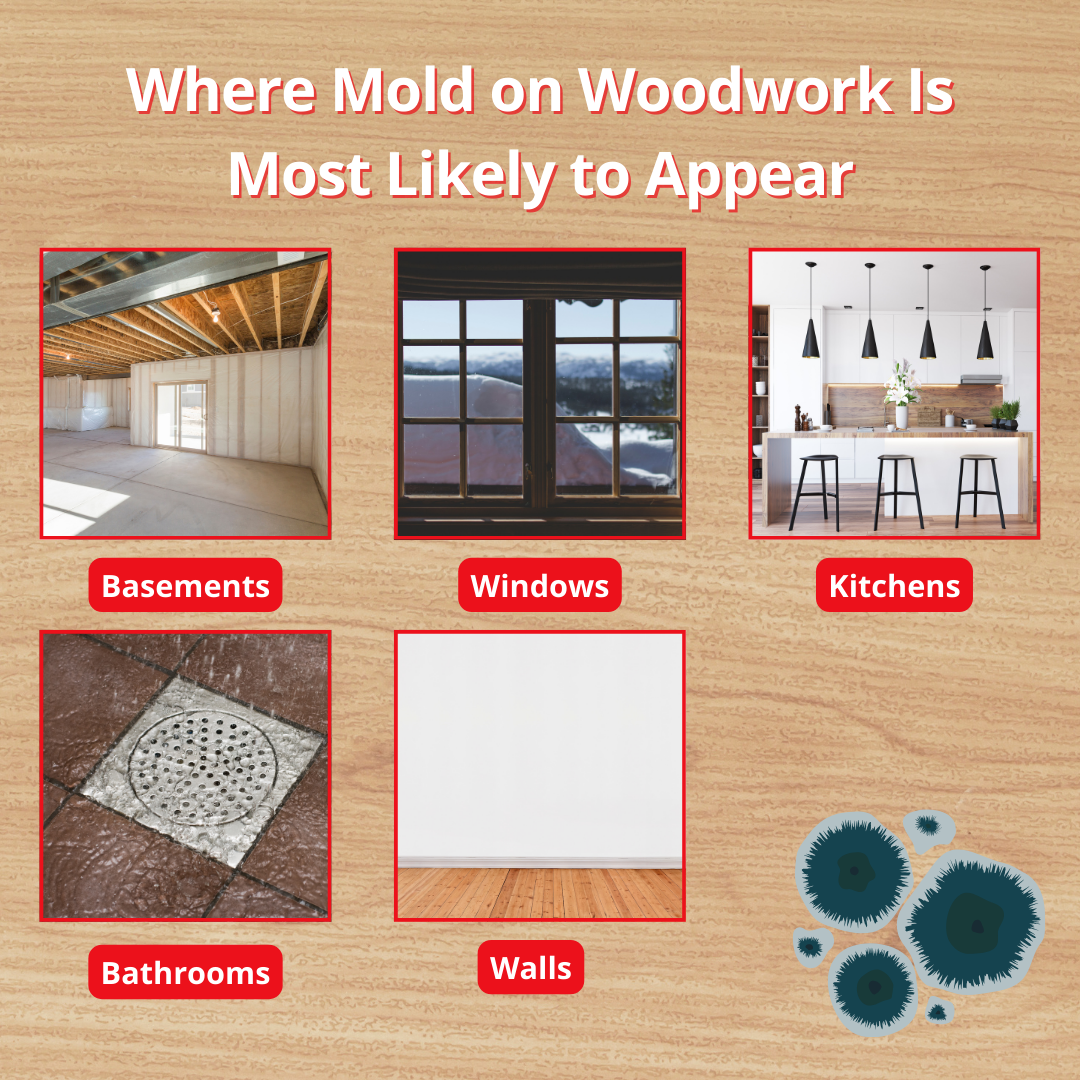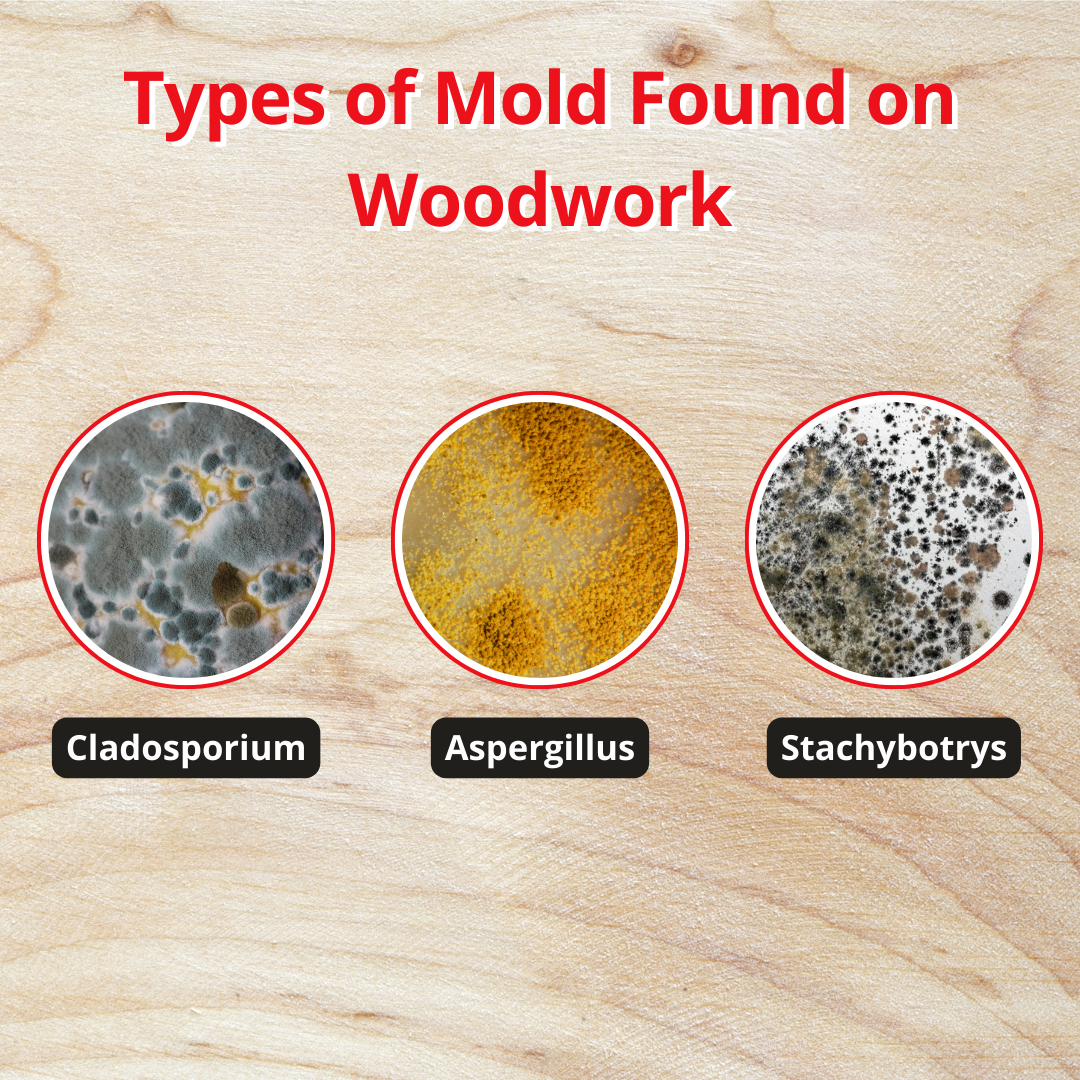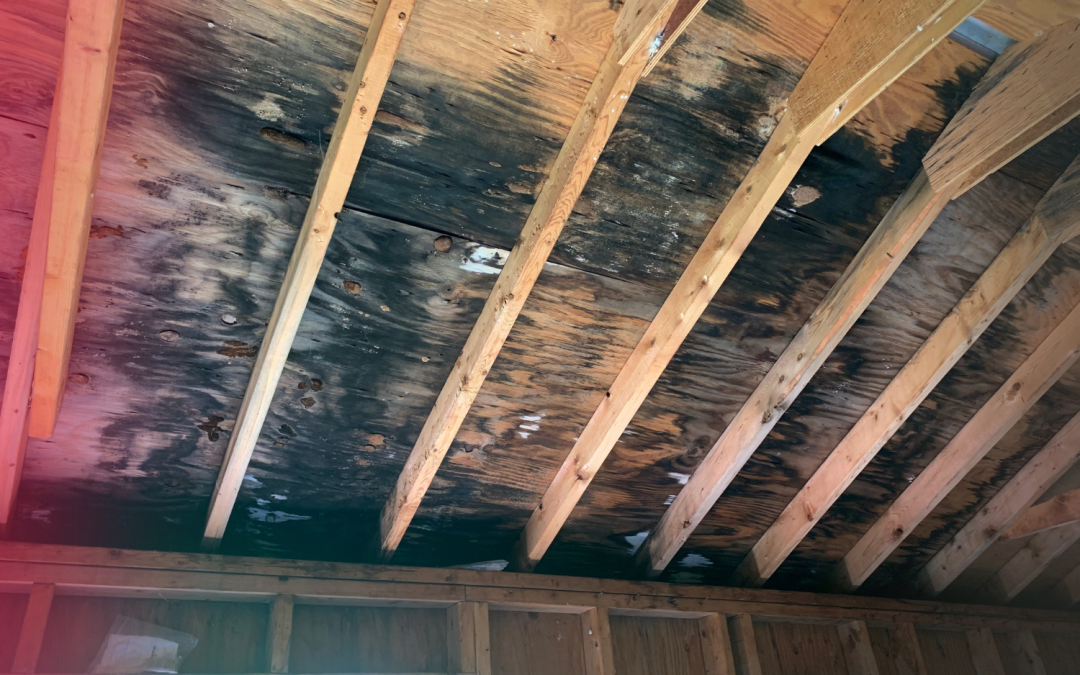Mold on woodwork is a common problem that can harm your home and health if left untreated. The good news is that early signs are easy to spot once you know what to look for. By checking for discoloration, musty smells, or changes in wood texture, you can catch mold before it spreads and causes costly repairs.
What Causes Mold on Woodwork in Homes?
Mold needs three things to grow: moisture, organic material, and poor airflow. Woodwork in your home provides the perfect surface, and moisture makes it worse. Common causes include:
- Leaky pipes behind walls
- Roof leaks that drip onto ceilings and trim
- High humidity in bathrooms, kitchens, or basements
- Condensation around windows and doors
When these conditions go unchecked, mold can begin to grow within just 24 to 48 hours.

Where Mold on Woodwork Is Most Likely to Appear
Knowing where to look helps you catch mold early. Wood trim, cabinets, and baseboards are common trouble spots. Mold often appears in:
- Basements and crawl spaces with damp air
- Bathrooms around sinks, tubs, and showers
- Kitchens near sinks, dishwashers, and under cabinets
- Around windows or skylights where condensation forms
- Behind heavy furniture pushed against exterior walls
These hidden areas may not be part of your daily cleaning routine, which makes them easy to miss.
How to Spot Mold on Woodwork Before It Spreads
Mold on woodwork shows up in different ways depending on the type and location. Look for these signs:
- Visual changes: black, green, or white patches, fuzzy growth, or bubbling paint
- Odors: a musty smell that lingers even after cleaning
- Texture: wood feels soft, warped, or crumbly
- Clues nearby: water stains, condensation, or damp drywall
Tip: Dirt or old stains can look like mold. If the spot keeps spreading, has a fuzzy texture, or gives off a musty odor, it’s likely mold.
Types of Mold Found on Woodwork
Several kinds of mold can grow on wood in homes. Some are harmless, while others are more concerning:
- Cladosporium: often dark or black spots on painted wood or trim
- Aspergillus: a powdery mold that appears indoors in damp areas
- Stachybotrys: also called “black mold,” linked to water-damaged wood
You don’t need to identify the exact type to take action. Any mold on woodwork should be addressed quickly.

Why Early Detection Matters
Catching mold early prevents bigger problems. Here’s why it matters:
- Lower costs: Treating a small patch is cheaper than full remediation. The average mold cleanup costs $1,500–$6,000 depending on size.
- Protecting your home: Left alone, mold can damage trim, cabinets, or even hardwood floors.
- Health benefits: Mold spores can trigger allergies, asthma, or respiratory issues.
- Stopping spread: Mold often travels behind walls or under flooring, where it’s harder to see.
DIY vs. Professional Mold Identification
Homeowners can handle small, surface-level mold, but larger problems need a professional.
- DIY safe zone: Cleaning a small patch (under 10 square feet) with soap or vinegar while wearing gloves and a mask.
- When to call a pro: If the mold keeps coming back, covers a large area, or is linked to a leak or hidden water damage.
Professional inspectors can use tools to find mold behind walls, test indoor air quality, and confirm the source of moisture. [Learn more about mold testing services here.]
What to Do If You Find Mold on Woodwork
If you see mold, here’s how to respond:
- For small spots: Clean with mild detergent or vinegar and dry the area fully. Avoid bleach on porous wood, it doesn’t penetrate deeply.
- Don’t paint over mold: Covering it up won’t solve the problem.
- Check for moisture: Mold won’t stop unless the water source is fixed.
- Call a professional: For large growth, repeated mold, or health concerns, schedule an inspection.
Prevention Tips to Keep Mold off Woodwork
Prevention is the best way to protect your home. Simple steps include:
- Control humidity: Keep indoor humidity between 30–50% using dehumidifiers or air conditioners.
- Ventilation: Use fans in bathrooms and kitchens. Open windows when possible.
- Check for leaks: Inspect plumbing, roofs, and window seals regularly.
- Seal wood: Use paint or sealant to protect exposed wood from moisture.
- Schedule seasonal inspections: Professionals can spot hidden risks before they turn into major problems.
Health Concerns from Mold on Woodwork
Mold isn’t just unsightly; it can affect your health. Common symptoms include:
- Sneezing and a runny nose
- Itchy or watery eyes
- Coughing and throat irritation
- Worsening asthma or allergies
Children, seniors, and anyone with weakened immune systems are more at risk. If you suspect mold is impacting your health, it’s important to take action quickly.
Related Questions
Can mold on woodwork make you sick?
Yes. Even small amounts can cause allergy-like symptoms or worsen asthma. It’s important to take care of mold on woodwork to avoid an increase in health issues.
Is black mold on woodwork always dangerous?
Not all black mold is toxic, but all mold should be treated seriously. Our home inspection services include a mold sample so you can properly treat mold.
How do inspectors test for hidden mold?
They may use moisture meters, air testing, and thermal imaging to find mold behind walls or under floors.
What’s the difference between mold and mildew on wood?
Mildew is usually gray and powdery, while mold can be green, black, or fuzzy.
How can I prevent mold from coming back after cleaning?
Fix the water source, lower humidity, and keep wood surfaces clean and sealed.
Conclusion
Spotting mold on woodwork before it spreads can save you time, money, and stress. Watch for discoloration, odors, and wood damage in areas with moisture. Take action early with cleaning or professional help to keep your home healthy and safe.
If you suspect mold in your home or want peace of mind, schedule a professional mold inspection with Harmony Inspection Services. A detailed inspection can uncover hidden issues and give you clear next steps to protect your home.

